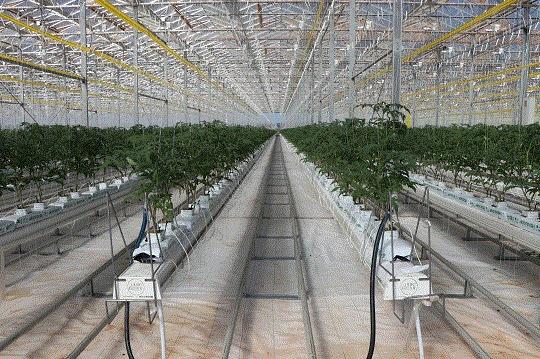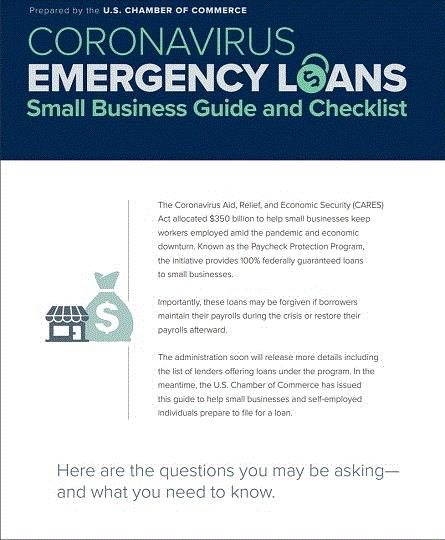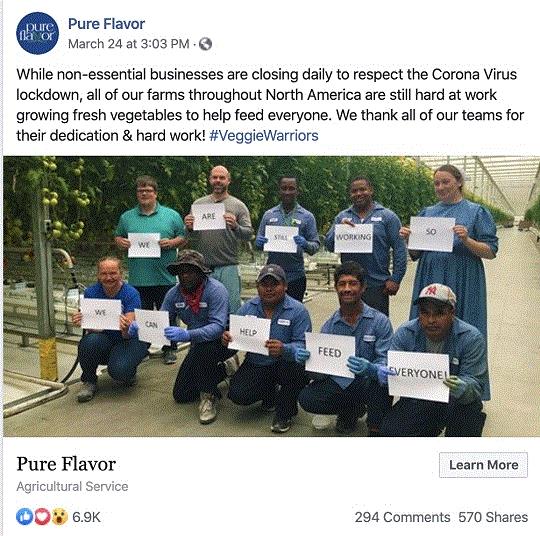CEA COVID-19 Response Part 1
Our uncertain times have grown even more uncertain with the continued spread of COVID-19. In these difficult times, I reached out to controlled environment ag growers to see how it’s impacting their operations and how they're reacting.

Here’s a Q&A with Sarah Krzysik, public relations coordinator with NatureFresh Farms, a hydroponic grower of tomatoes, cucumbers and peppers with operations in Canada and the U.S. (specifically in Delta, Ohio—you may remember them from our February 2017 Inside Grower cover story).
Q: How is demand for produce?
SK: All areas within the fresh produce supply chain felt the rush in demand during the first week to 10 days to fill the immediate consumer demand. This has leveled off now, however, we anticipate that we will see another surge as consumers eat the fresh fruits and vegetables purchased last week. We are confident that with the beginning of our Ontario greenhouse production and our year-round production of greenhouse tomatoes, we will continue to manage the increase well, with no interruption of supply and service to our retail customers.
Q: Are you experiencing any challenges related to staffing and labor?
SK: In regard to labor, given the current COVID-19 restrictions on travel and entry to Canada for short-term labor, there is an immediate and growing need for agriculture workers. Just over half of our total workforce comes from our local area, filling positions from sales, management and marketing to logistics and harvesting. However, we also depend on international workers who come from Mexico, Guatemala, Honduras and the Caribbean, and over the next six weeks we’re awaiting the arrival of 140 more workers. The priority now is being able to get them here in a timely fashion.
Q: Have you implemented any additional safety measures?
SK: We’re committed to doing what we can to keep all of our employees safe. We have enough housing to properly isolate our newly arriving workers for 14 days, and our food safety certifications mean we already have extensive cleaning and hygiene protocols in place that our workers are very familiar with. We continue to review and implement new protocols and have set up a committee where we tasked each department to bring forward the top things that the department, the company and the workers can do to protect themselves.
Q: Is it any different between the U.S. operations and Canadian greenhouses?
SK: We have kept in contact with our team in Delta, Ohio, and they have informed us that they are continuing to meet demands and have a sufficient number of employees during this time. In terms of the differences between U.S. and Canada, I would say that the challenges are very much the same. There are some regionally specific challenges, but nothing outstanding. These are difficult and trying times, and our staff—and indeed the entire sector—has stepped up to the challenge of keeping grocery stores supplied.

CEA COVID-19 Response Part 2
I also heard back from Chris Veillon, Chief Marketing Officer at Pure Flavor, a hydroponic grower of tomatoes, peppers, cucumbers and eggplant based in Leamington, Ontario, that has a newer greenhouse in Peach County, Georgia, and also has operations in Mexico.
Here are his thoughts:
We are doing well, picking crops across all of our family of growers throughout Canada, USA and Mexico.
The demand over the last few weeks had been intense, but has somewhat subsided this week as things start to stabilize at retail. Fresh, new, Canadian crops are now starting to come online. We continue to ship year-round.

The Peach County, Georgia, Pure Flavor greenhouse.
Our facilities are clean, safe, and full with healthy and informed employees:
-
This is being monitored daily
-
(We) increased supporting signage in offices, distribution centers, farms and pack houses to ensure everyone is up to speed and aware
The company has increased precautions across all facilities to ensure that a safe work environment is created for all:
-
As an essential business, we continue to operate on a daily basis
-
For those departments that have the ability to work remotely, this has been put into action for people to telecommute (we are a fully integrated company with the best of technology at our disposal, and more Teams & Zoom video chats have been implemented for employees to access at any point in time)
The company has already started providing meals a number of times per week for those who are coming to work, as well as providing dry goods/non-perishable items for employees to take home, free of charge.
My sincere thanks go out to both Sarah and Chris for taking the time to relay their thoughts and their companies’ efforts. I’d love to hear from other operations, if you have a moment. Please drop me a line at jpolanz@ballpublishing.com to let me know how this pandemic is impacting your operation.

Visit our COVID-19 Resource Page

We've spent the last two weeks (or more, all the days are starting to run together now) compiling resources and links to resources for our readers. The scope of our publications extend across multiple industries, from CEA to ornamental growers, garden retailers, florists, landscapers, vendors and allied trade. We tried to cover as much as we could related to impact on all of these segments.
For grower-specific resources, visit www.growertalks.com/COVID-19 and you’ll find a list of stories and additional resources.
For retail, visit www.greenprofit.com/COVID-19.
In the next segment of this newsletter, you’ll find more details about the federal aid packages that have been passed by Congress. Additional resources related to those packages, including webinars that detail the application process, can be found on the respective COVID-19 web pages at AmericanHort.org and www.safnow.org. It should be noted that both organizations have opened all of these resources to non-members.

Federal Aid Explained
We're fortunate to have a great many associations producing resources in this industry and this week I was able to jump on a webinar hosted by the Society of American Florists (SAF) regarding accessing federal aid. SAF Senior Lobbyist Joe Bischoff detailed the two stimulus packages that would apply to most operations in the green industry, including CEA growers. Here are a few highlights from the webinar:
He first talked about the Economic Injury Disaster Loan (EIDL) program that came as part of the initial $8.3 billion stimulus package passed by Congress. The EIDL program applies to small agricultural cooperatives and provides up to $2 million in non-forgivable loans with a 3.75% interest rate and up to 30-year terms. This stimulus also offered the Economic Injury Disaster Advanced Loan, which allows an entity to receive up to $10,000 within three days of submission, which does not have to be repaid.

The U.S. Chamber of Commerce's Guide to Emergency Loans.
He next detailed the Paycheck Protection Program (PPP) from the latest $2 trillion CARES stimulus package. The PPP pertains to businesses and non-profits with fewer than 500 employees, as well as private contractors, and waives the upfront paperwork. Those who are applying have to make a good faith statement about their operation and need.
The PPP loans cover up to 2.5 times the amount of monthly expenses up to $10 million. Applicants can use the loan to cover qualified payroll, interest on debt, rent and utilities. If the loan is used for qualified expenses for an eight-week period (beginning on the date of the origination of the loan), it will be forgiven, as long as certain parameters are met, like retention of employees and wage amounts. If used outside of those qualifications, it will be paid back at an interest rate capped at 4%.
Couple of good-news items—if you already applied for the EIDL program (which, as you remember, is non-forgivable), you can apply for PPP and be rolled into that program (which is forgivable), Joe says. Also, the forgiven debt from the PPP will not be treated as income for tax purposes. The loans will be available through Small Business Association (SBA) and Treasury-approved banks, credit unions and other qualified lenders.
So we’ve covered the details for those under 500 employees, but there’s also the Treasury Department’s Exchange Stabilization Fund (ESF) for businesses with 500 to 10,000 employees. Joe notes the details on this aren't quite as clear, but those who apply are required to retain at least 90% of their employees at full compensation and benefits until September 30. There are lots of limits on this one and it's unknown when the application will be available.
CLICK HERE to see Joe’s archived webinar and visit www.safnow.org to see other webinars related to business and retail.
I wasn't able to attend this one, but AmericanHort sponsored a webinar about the CARES Act from the Ag Consulting Firm K-Coe Isom. CLICK HERE for that webinar.
The U.S. Chamber of Commerce has an excellent guide to the PPP HERE, as well as a downloadable guide to all the loans available.

The Good With the Bad
I’m determined to not let you leave this newsletter without at least some good news. I have a couple items that might help. When Chris Veillon sent over his report, he also sent a pic they posted to their Instagram and Facebook pages thanking their greenhouse teams (AKA Veggie Warriors). The Facebook post received nearly 300 responses, mostly thanking the workers (and a few reminding of social distancing, which they promised to do next time). People are thankful for the work our industry does every day.

I also wanted to call out Sakata Seed America for its recent good deed. See, there are people at Sakata who use respiratory masks and gloves as part of the company’s safety protocols during the seed treating and handling process. One of these seed production and treatment facilities is in Washington State’s Skagit County, and in late March they donated three cases of masks and gloves to the Skagit Valley Hospital campus.
“It’s our social responsibility as a company that calls this community (along with many others) home,” says Tye Anderson, director of production and logistics at Sakata. “We are in this together and are dedicated to doing our part to help fight this any way we can. As an ‘essential business,’ Sakata continues to operate as part of the country’s food chain, supplying nourishment to our nation, however, any other way we can find to contribute, big or small—we will do so.”
#TogetherApart
Stay safe and don’t forget your social distancing. As a local Cleveland eatery pointed out, 6 feet equals a string of 12 Slovenian smoked sausages. Just in case you were wondering (this is why I love the CLE).




As always, feel free to email me at jpolanz@ballpublishing.com with comments, questions, news and views.
Until next time, stay safe and be healthy,

Jennifer Polanz
Editor-at-Large
Inside Grower
This email received by 24,304 loyal readers!
Interested in advertising in Inside Grower? Contact Paul Black or Kim Brown and they'll show you how easy, effective and affordable it is.